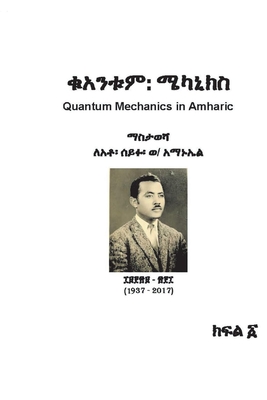
Quantum Mechanics in Amharic
Description
Quantum Mechanics in Amharic, to my knowledge, is the first book on quantum mechanics to use the rich expressions of the Amharic language, which has a long history. Since the late twelfth century, Amharic has been the working language of Ethiopia's courts, military, trade, and daily communication, and it remains the country's official language. The recent census indicates that there are 22 million native Amharic speakers and 4 million secondary speakers in Ethiopia. There are also over 3 million Amharic-speaking emigrants outside Ethiopia. The Ethiopian Jewish communities in Ethiopia and Israel as well as the Ethiopian diaspora in and around Washington, D.C. speak Amharic. Amharic is one of the six non-English languages included in Washington's Language Access Act of 2004, thus ensuring citizens access to government services and education in Amharic. While Ethiopian Christians regard Ge'ez—Amharic's root language—as holy, Amharic is the holy language of the Rastafari religion and is widely used by its followers worldwide. The script of the Amharic language is known as an abugida, and the graphemes of its writing system are called fidel. These graphemes are displayed on the last page of Quantum Mechanics in Amharic surrounded by the green, yellow, and red of the original Ethiopian flag, which remains an icon of freedom because Ethiopia is the only non-colonized nation in Africa. Each fidel, which represents a consonant and vowel sequence, has a shape determined by its consonant and modified by its vowel.
The primary language of quantum mechanics, one of the many branches of physics, is mathematics. However, everyday language is required to explain in depth the laws of physics that are presented using mathematical expressions. The book's introduction briefly describes the historical roots of quantum mechanics, starting with natural philosophy from 400 BC. Although some civilizations, such as Ethiopia's Aksumite civilization, date well before this to 3000 BC, there are some indications of knowledge transfer from earlier civilizations to more recent ones. The book then follows the historical timeline through the present state of quantum mechanics, describing several interesting phenomena that can only be explained using quantum mechanics, such as quantum tunneling, causality, the nature of reality, duality, entanglement, superposition, and quantum scattering. The first three of these are described in detail. The first chapter briefly explains the underlying physics essential to understanding quantum mechanics. It also explores some current quantum mechanics research and potential future applications, including quantum computers, quantum teleportation, and nano-science/technology. The second chapter presents the Schrödinger equation and the wave function, including wave-particle duality. The third chapter introduces readers to the time-independent Schrödinger equation and its applications in solving the state of a one-dimensional particle in five different potentials. The end of the book includes translations of over 130 words and lists a few useful references. Readers are given exercises to complete throughout the book, including proofs after example proofs are presented.
Books such as Quantum Mechanics in Amharic that are written in indigenous languages on advanced topics will be useful for the Einstein Project in Africa. It has been over a century since 1905, the so-called "Miracle Year" of Einstein, and the world has not since witnessed another scientist of his caliber. It is possible that his successor will be a child in Africa who does not have access to modern education. Science books in indigenous languages may help lift this barrier.





